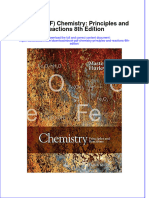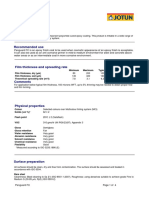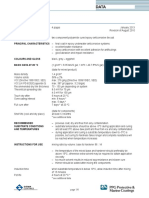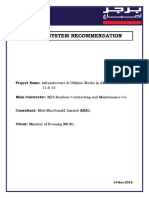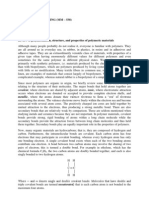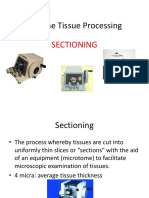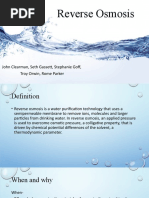Transpoxy Barrier 9216
Transpoxy Barrier 9216
Uploaded by
Kevin Rahmanda S.Copyright:
Available Formats
Transpoxy Barrier 9216
Transpoxy Barrier 9216
Uploaded by
Kevin Rahmanda S.Original Title
Copyright
Available Formats
Share this document
Did you find this document useful?
Is this content inappropriate?
Copyright:
Available Formats
Transpoxy Barrier 9216
Transpoxy Barrier 9216
Uploaded by
Kevin Rahmanda S.Copyright:
Available Formats
Transpoxy Barrier 9216
Product description.
A tarfree, polyamide cured epoxy coating with an excellent seawater- and corrosion resistance.
Transpoxy Barrier offers good levelling- and wetting properties which enables tolerance to a lower
degree of surface preparation.
Physical properties.
Colour Grey, Redbrown
Texture Semi-gloss
Volume Solids Approx. 67%
Specific gravity Approx. 1.30 gr/ml
VOC Approx. 300 gr/liter
Flashpoint >16°C
Dry film thickness per Wet film thickness per Theoretical spreading
coat (µm) coat (µm) rate (m2/l)
Range 100 - 200 150 - 300 6.7 - 3.4
Recommended 150 225 4.5
Application data.
Mixing ratio By volume, base to hardener: 66.7 / 33.3
Potlife 10°C: 8 hours, 23°C: 6 hours, 30°C: 4 hours
Guiding data Pressure at nozzle: 180 - 250 bar. Nozzle size: 0.53 - 0.66 mm.
Airless spray Spray angle: 40 - 80 degrees.
Volume of thinner: 0 - 5%.
Guiding data Not applicable
Airspray
Brush Suitable.
Multicoats are required to achieve the specified dry film thickness. Volume of
thinner: 0 - 5%.
Roller Suitable.
Multicoats are required to achieve the specified dry film thickness. Volume of
thinner: 0 - 5%.
Thinner/Cleaner Transocean Epoxy Thinner 6.03
Avoid excessive thinning as it will result in lower sag resistance and slower cure.
Also it may cause solvent entrapment resulting in possible blistering, pin holing
and poor adhesion.
Datasheet Transpoxy Barrier 9216, Page 1 of 3.
Drying and recoating times (1)
Substrate Touch dry Dry to handle Full cure Dry to recoat Dry to recoat
temperature Minimum Max.(2)
10°C 8 Hours 24 Hours 14 Days 18 Hours 14 Days
23°C 6 Hours 16 Hours 7 Days 12 Hours 10 Days
30°C 4 Hours 12 Hours 5 Days 12 Hours 7 Days
(1)The given data are for guidance only as actual drying times may be shorter or longer, depending on film thickness, ventilation, humidity,
preceding paint system etc.
(2)The best intercoat adhesion is achieved when the subsequent coat is applied before the preceding coat is fully cured. After prolonged
exposure times it may be necessary to roughen the surface to ensure intercoat adhesion. When in doubt, consult your nearest Transocean
office.
Surface Preparation
Blast cleaning
The performance of this paint will depend on the degree of surface preparation.
All surfaces should be clean, dry and free from contamination. Surfaces should be treated in
accordance with ISO 8504:2000.
The surfaces shall be blast-cleaned to min. Sa 2, preferably Sa 2½ (ISO 8501-1:2007). The surface
profile and the anchor pattern shall be between 40 µm and 70 µm. The abrasives shall be free from
oil, grease, moisture, chloride contamination etc.
Power tool Cleaning
The performance of this paint will depend on the degree of surface preparation.
Surfaces should be treated in accordance with ISO 8504:2000. The surface shall be cleaned by
high pressure steam/detergent cleaning to remove dirt, grease and/or salt deposits in accordance
with SSPC SP1.
Power-tool cleaning to min. St 2, preferably St 3 (ISO 8501-1:2007). Care shall be taken to ensure
that power-tool cleaning does not polish the steel surface. If the surface being prepared lies
adjacent to a coated surface, the power tool cleaning shall overlap the coated surface by at least 25
mm and the coated surface shall be feathered.
Water jetting
Surfaces should be treated in accordance with ISO 8504:2000. All surfaces should be clean, dry
and free from contamination.
Water jetting in accordance to ISO 8591-4: 2006 to a cleanliness of Wa 2 or better for atmospheric
exposure and Wa 2,5 for immersion. Acceptable flash rust degree is M (medium) but degree L
(light) is preferred.
A water pressure of at least of 1000 bar (approx. 15.000 psi) is recommended.
Coated substrates
All surfaces should be clean, dry and free from contamination. Surfaces should be treated in
accordance with ISO 8504:2000.
Ensure compatibility of the coated substrates with the selected paint system. If the remaining part of
the existing coating system needs to be sweep-blasted, fine abrasive shall be used to avoid
damage to the coating system.
When recoating aged coated substrates, damaged areas must be removed back to a firm edge.
Light abrade or sweep-blast the surface in order to provide a physical key for adhesion.
When recoating zinc primed products, ensure the primer has been fully cured. Zinc salts products
shall be removed by high pressure fresh water cleaning.
Contact your local Transocean office for more information.
Datasheet Transpoxy Barrier 9216, Page 2 of 3.
Typical paint system
A typical system for this product is shown below and should be taken for guidance only. A full
system specification where all details are taken into consideration can be obtained through your
local Transocean representative.
Transpoxy Barrier 9216 Recommended: 150µm DFT
Transpoxy Barrier 9216 Recommended: 150µm DFT
Transpoxy Barrier 9216 Recommended: 150µm DFT
Transpoxy Barrier 9216 Recommended: 150µm DFT
Transpoxy Barrier 9216 Recommended: 125µm DFT
Transpoxy Barrier 9216 Recommended: 125µm DFT
Transpoxy Barrier FF-Mio Recommended: 150µm DFT
Transpoxy Barrier FF-Mio Recommended: 150µm DFT
Application conditions
The temperature of the substrate should be at least 3°C above the dew point of the air.
Temperature and relative humidity should be measured in the vicinity of the substrate.
The maximum recommended surface temperature is approx. 40°C. Higher steel temperatures are
acceptable provided dry-spray is avoided by proper spray application and extra thinning if required.
In extreme cases it may be necessary to reduce film thickness in order to avoid sagging.
When applying the paint in confined spaces, provide adequate ventilation during application and
drying.
The temperature of the mixed paint should be at least 15°C, otherwise extra solvent may be
required to obtain a proper application viscosity.
Storage and shelf life
The product must be stored in accordance with national regulations. The cans are to be kept in a
dry, cool, well ventilated space and away from source of heat and ignition. Cans must be kept
tightly closed.
Worldwide availability
The product is part of the common Transocean product range but local availability is subject to
confirmation. Although we strive to supply the same product through the world, slight modifications
of the product in some cases may be necessary in order to comply with local conditions and/or
national regulations. In such cases an alternative datasheet will issued.
Health and safety
Observe the precautionary notices on the label of the container. A material safety data sheet is
available upon request and national or local safety regulations should be followed. This product is
intended for use by professional applicators.
As a general rule, avoid skin- and eye contact by wearing overalls, gloves, goggles, mask, etc.
Spraying should be carried out under well-ventilated conditions. This product contains flammable
materials and should be kept away from sparks and open flames. Smoking in the area should not
be permitted.
Disclaimer
The information in this data sheet is provided to the best of our knowledge. However, we have no
control over either quality or condition of the substrate and other factors affecting the use and
application of this product. Therefore, we cannot accept any liability whatsoever or howsoever
arising from the performance of the product or for any loss or damage arising from the use of this
product. We reserve the right to change the product without notice.
MID Number: 9216-1003
Date of issue: May 2014
Datasheet Transpoxy Barrier 9216, Page 3 of 3.
You might also like
- Ebook PDF Chemistry Principles and Reactions 8th Edition PDFDocument41 pagesEbook PDF Chemistry Principles and Reactions 8th Edition PDFbruce.roth349100% (51)
- Transpoxy Tar 211Document3 pagesTranspoxy Tar 211Kevin Rahmanda S.No ratings yet
- Transozinc Epoxy Primer 175Document5 pagesTransozinc Epoxy Primer 175Tirumala PrasadNo ratings yet
- Transolac Undercoat 321Document2 pagesTransolac Undercoat 321mido medoNo ratings yet
- Transpoxy ShopprimerDocument5 pagesTranspoxy ShopprimerTirumala PrasadNo ratings yet
- Transpoxy Tankguard 118 ESDocument5 pagesTranspoxy Tankguard 118 ESFadi MagdyNo ratings yet
- Product Data Sheet: Transpoxy Masterbond 4.68Document2 pagesProduct Data Sheet: Transpoxy Masterbond 4.68rajeshNo ratings yet
- Transunilac Finish 331Document4 pagesTransunilac Finish 331bhukyanaik02No ratings yet
- TO 1.58 Transozinc Silicate 158 ENDocument5 pagesTO 1.58 Transozinc Silicate 158 ENTirumala PrasadNo ratings yet
- TDS - 373 - SeaQuantum Ultra - Eng - USDocument4 pagesTDS - 373 - SeaQuantum Ultra - Eng - UShendra.siskal001No ratings yet
- TDS - 372 - SeaQuantum Plus - Eng - USDocument4 pagesTDS - 372 - SeaQuantum Plus - Eng - UShendra.siskal001No ratings yet
- Transpoxy Masterbond 4.67NDocument2 pagesTranspoxy Masterbond 4.67NAhmed FodaNo ratings yet
- Transoprene Primer 1.25Document2 pagesTransoprene Primer 1.25Tirumala PrasadNo ratings yet
- Transpoxy Masterbond BT 4.68 ProDocument3 pagesTranspoxy Masterbond BT 4.68 ProMuhammad Asyraf MahatNo ratings yet
- PDS Simacover Tar Epoxy 3404-00Document4 pagesPDS Simacover Tar Epoxy 3404-00Aulia RahmahNo ratings yet
- Epilux 44 Enamel: Product Data Resistance GuideDocument2 pagesEpilux 44 Enamel: Product Data Resistance GuideKishore Nayak kNo ratings yet
- TDS Jotun Seaconomy 900 - AFDocument4 pagesTDS Jotun Seaconomy 900 - AFANo ratings yet
- Sam Epoxy Primer ZP - ECDocument3 pagesSam Epoxy Primer ZP - ECqcahmedsobhyNo ratings yet
- Transbarrier Anticorrosive 2.02_1605177556Document2 pagesTransbarrier Anticorrosive 2.02_1605177556Tirumala PrasadNo ratings yet
- TDS-PDF-Interchar 1290 Eng A4 20170228Document4 pagesTDS-PDF-Interchar 1290 Eng A4 20170228shameelNo ratings yet
- Sam Classic FinishDocument2 pagesSam Classic FinishMo MosadNo ratings yet
- Carboguard 890 PDSDocument2 pagesCarboguard 890 PDSLinnie McleodNo ratings yet
- Transpoxy Primer 1.16Document2 pagesTranspoxy Primer 1.16thinesNo ratings yet
- Carboguard 89dfsfs0 PDSDocument2 pagesCarboguard 89dfsfs0 PDSMayur PatelNo ratings yet
- 3 - PC 7049 - Apcodur MioDocument3 pages3 - PC 7049 - Apcodur Miosujay AvatiNo ratings yet
- TDS - 370 - SeaQuantum Classic - Euk - GBDocument4 pagesTDS - 370 - SeaQuantum Classic - Euk - GBhendra.siskal001No ratings yet
- TDS - Barrier 90 - English (Uk) - Issued.05.10.2011Document4 pagesTDS - Barrier 90 - English (Uk) - Issued.05.10.2011ansarALLAAHNo ratings yet
- Penguard FC: Technical DataDocument4 pagesPenguard FC: Technical DataMohamed FarhanNo ratings yet
- Transpoxy Masterbond 4.67N (FLOORING GRADE)Document3 pagesTranspoxy Masterbond 4.67N (FLOORING GRADE)Sami KahtaniNo ratings yet
- T.o.1.55 (Zinc Rich Epoxy Primer)Document2 pagesT.o.1.55 (Zinc Rich Epoxy Primer)Sachin NambiarNo ratings yet
- Dulux Protective Coatings Metalshield Cold Galv Primer PrimerDocument4 pagesDulux Protective Coatings Metalshield Cold Galv Primer PrimerS SathiyarubanNo ratings yet
- TDS Tankguard 412 English (Uk) Issued.22.05.2009Document4 pagesTDS Tankguard 412 English (Uk) Issued.22.05.2009Ahmed NabilNo ratings yet
- Sam Epoxy Primer 50Document3 pagesSam Epoxy Primer 50qcahmedsobhyNo ratings yet
- Sigmacover™ 300: Product Data SheetDocument6 pagesSigmacover™ 300: Product Data SheetinnovativekarthiNo ratings yet
- E Program Files An ConnectManager SSIS TDS PDF Interchar 1190 Eng A4 20200309Document4 pagesE Program Files An ConnectManager SSIS TDS PDF Interchar 1190 Eng A4 20200309Ramesh RathinamNo ratings yet
- TDS - Penguard Primer - Issued.26.11.2010Document4 pagesTDS - Penguard Primer - Issued.26.11.2010vitharvanNo ratings yet
- National Universal Epoxy PrimerDocument4 pagesNational Universal Epoxy PrimeraswinkovilakamNo ratings yet
- TDS - Penguard Topcoat - English (Uk) - Issued.26.11.2010 PDFDocument4 pagesTDS - Penguard Topcoat - English (Uk) - Issued.26.11.2010 PDFNPTNo ratings yet
- Sigma Marine Coatings Manual - Part73Document2 pagesSigma Marine Coatings Manual - Part73Tommy2020No ratings yet
- Sigma Marine Coatings Manual - Part56Document2 pagesSigma Marine Coatings Manual - Part56EngTamerNo ratings yet
- TDS - Penguard HB - Issued.26.11.2010Document4 pagesTDS - Penguard HB - Issued.26.11.2010vitharvanNo ratings yet
- Hempadur Primer 15300Document3 pagesHempadur Primer 15300vitharvanNo ratings yet
- TDS - Penguard Midcoat - Issu.26.11.2010 PDFDocument4 pagesTDS - Penguard Midcoat - Issu.26.11.2010 PDFvitharvanNo ratings yet
- Garlock GSK 3-86 Strainer Gasket 04.2017 en-NADocument2 pagesGarlock GSK 3-86 Strainer Gasket 04.2017 en-NAAbuhurairah MunshiNo ratings yet
- Scheda Tecnica Seaforce 90Document4 pagesScheda Tecnica Seaforce 90Sirya ZetaNo ratings yet
- PDS - NP ProSeal 150-High Build Fast Dry Epoxy PrimerDocument4 pagesPDS - NP ProSeal 150-High Build Fast Dry Epoxy PrimerSamsuNo ratings yet
- 00 - 6823 SigmaCover 410Document4 pages00 - 6823 SigmaCover 410Mohammed AdilNo ratings yet
- Berger Coating StandardsDocument9 pagesBerger Coating StandardsHariHaranNo ratings yet
- Berger: Product SpecificationsDocument2 pagesBerger: Product SpecificationsAabhas UpadhyayaNo ratings yet
- Jotun Malathon TDSDocument5 pagesJotun Malathon TDSBiju_PottayilNo ratings yet
- Interline 925PDocument4 pagesInterline 925Ptiennv.cmblNo ratings yet
- Interzone 954Document0 pagesInterzone 954hennawijayaNo ratings yet
- Interchar 1260 DatasheetDocument5 pagesInterchar 1260 DatasheetVanessa CamposNo ratings yet
- Coaltar EpoxyDocument3 pagesCoaltar EpoxyAkhtar aliNo ratings yet
- Interchar 1190: Water Borne Intumescent CoatingDocument4 pagesInterchar 1190: Water Borne Intumescent Coatingsubham sahuNo ratings yet
- TDS - Chemflake Classic - English (Uk) - Issued.25.10.2013Document5 pagesTDS - Chemflake Classic - English (Uk) - Issued.25.10.2013Khaled GamalNo ratings yet
- Plasite 9133 Product Data SheetDocument3 pagesPlasite 9133 Product Data SheetChris StroudNo ratings yet
- Apcosil 605 IzssDocument3 pagesApcosil 605 IzssPavul RajNo ratings yet
- B B B Berger Erger Erger Erger: Product SpecificationsDocument2 pagesB B B Berger Erger Erger Erger: Product SpecificationsAabhas UpadhyayaNo ratings yet
- Apcotherm Epn 200Document2 pagesApcotherm Epn 200Moin AltafNo ratings yet
- Bonding QuizDocument7 pagesBonding Quiz卜一斐No ratings yet
- Separation TowerDocument68 pagesSeparation TowersasiNo ratings yet
- LC-MS/MS For The Determination of Four Water Soluble Vitamins: Method Development, Validation and Comparison To EC MethodDocument6 pagesLC-MS/MS For The Determination of Four Water Soluble Vitamins: Method Development, Validation and Comparison To EC MethoddewiNo ratings yet
- Fiche Technique 95751Document1 pageFiche Technique 95751benoitgeoffriauNo ratings yet
- Synopsis 4Document11 pagesSynopsis 4praveen komathNo ratings yet
- Biochem Lab - Lipids (Corpuz, R)Document6 pagesBiochem Lab - Lipids (Corpuz, R)Reynand MaelNo ratings yet
- Matter Test Reviewanswers-HonorsDocument2 pagesMatter Test Reviewanswers-HonorsLisa MondaNo ratings yet
- Standoff Insulator BMC DataDocument1 pageStandoff Insulator BMC DataSwapnil KiniNo ratings yet
- CorrosionDocument30 pagesCorrosionNikhilNo ratings yet
- Micropipettes GuideDocument26 pagesMicropipettes Guidebhavatharani19112001No ratings yet
- Diazonium Compound 0 1Document12 pagesDiazonium Compound 0 1Marwan FarhanNo ratings yet
- Lecture No.01 Polymer EngineeringDocument16 pagesLecture No.01 Polymer Engineeringmm11_nedNo ratings yet
- 2 Mixture and AlligationsDocument16 pages2 Mixture and Alligationsexamqualifiers21No ratings yet
- Calculating A and Percent Abundance Example 1: Boron Has Two Naturally Occurring IsotopesDocument9 pagesCalculating A and Percent Abundance Example 1: Boron Has Two Naturally Occurring IsotopesJessica DobrinNo ratings yet
- Bitumen Emulsion ProductionDocument4 pagesBitumen Emulsion ProductionkhalidvonsaleemNo ratings yet
- Damp Proofing & Termite ProofingDocument11 pagesDamp Proofing & Termite ProofingPrakarti Lulla100% (1)
- Uh7nox PDFDocument11 pagesUh7nox PDFBayu SomantaraNo ratings yet
- Textiles With Cosmetic EffectsDocument17 pagesTextiles With Cosmetic EffectsAhsan NazirNo ratings yet
- SR NEET STAR SUPER CHAINA (XII Syllabus GT-6) Q.P EX - DT. 15.03.2024Document24 pagesSR NEET STAR SUPER CHAINA (XII Syllabus GT-6) Q.P EX - DT. 15.03.2024divya202230014No ratings yet
- Restek USP GC-ColumnsDocument2 pagesRestek USP GC-Columnsfarkad rawiNo ratings yet
- High Quality CRA Solutions by Electroslag Process For Austenitic StainleDocument14 pagesHigh Quality CRA Solutions by Electroslag Process For Austenitic StainleMubeenNo ratings yet
- Oxidative Degradation of Pharmaceuticals PDFDocument17 pagesOxidative Degradation of Pharmaceuticals PDFJosue Ivan Buendia GarciaNo ratings yet
- Eil FormatDocument1 pageEil Formatsales.aquavalvesNo ratings yet
- Routine Tissue Processing: SectioningDocument33 pagesRoutine Tissue Processing: SectioningMarj MendezNo ratings yet
- Reverse Osmosis FixedDocument18 pagesReverse Osmosis FixedBenNo ratings yet
- Cell Bio Lab ReportDocument19 pagesCell Bio Lab ReportJohnNo ratings yet
- Classification of Boilers and Their Advantages and DisadvantagesDocument11 pagesClassification of Boilers and Their Advantages and Disadvantagesman330055No ratings yet
- vescomDocument24 pagesvescomAnaNo ratings yet
- Terminology of Soil Fertility, Fertilizer and Organics (PDFDrive)Document116 pagesTerminology of Soil Fertility, Fertilizer and Organics (PDFDrive)Heera Kardong100% (1)
